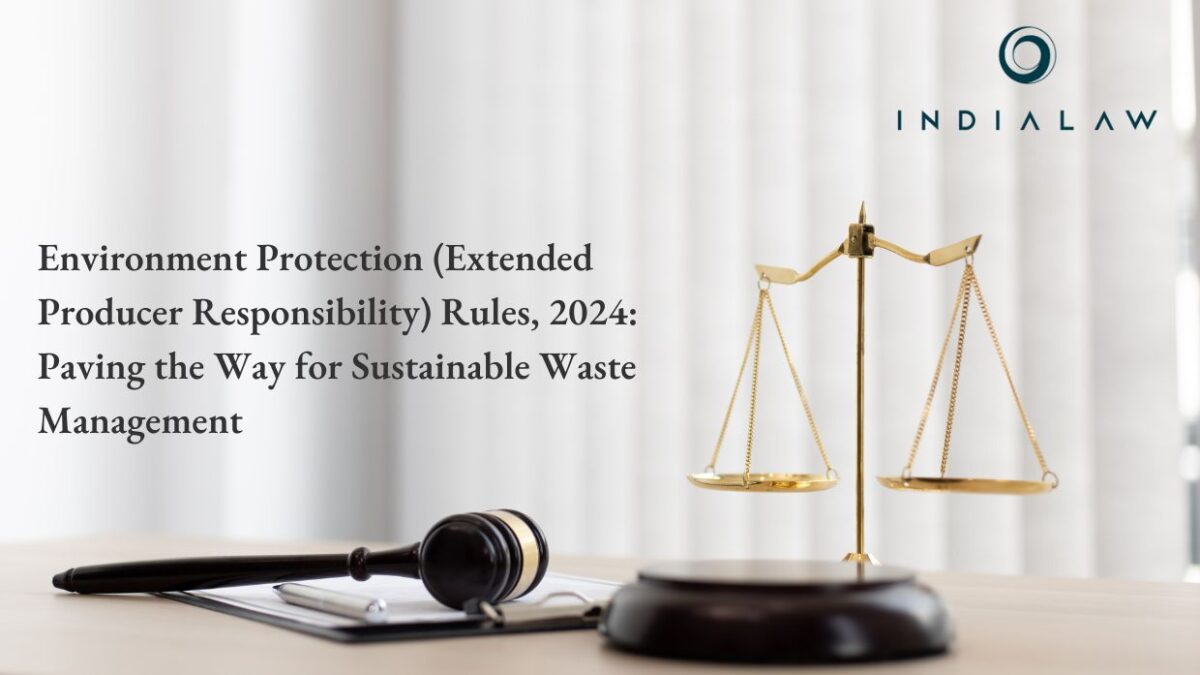Environment Protection (Extended Producer Responsibility) Rules, 2024: Paving the Way for Sustainable Waste Management


The draft Environment Protection (Extended Producer Responsibility for Packaging made from Paper, Glass, Metal as well as Sanitary Products) Rules, 2024 represents a milestone in India’s efforts toward sustainable waste management. Issued under the Environment Protection Act of 1986, these rules aim to transform waste management by holding producers accountable for the entire lifecycle of their products, from production to disposal.
Table of Contents
The Framework of Change
The draft rules are grounded in the principles of Extended Producer Responsibility (EPR), focusing on the environmental management of packaging waste. This encompasses materials like paper, glass, metal, and sanitary products, with an overarching goal to promote a circular economy. Through recycling, reuse, and energy recovery, the framework encourages a shift from traditional waste disposal methods to more sustainable practices.
Legislative Foundations and Applicability
The rules derive authority from Sections 3, 6, and 25 of the Environment Protection Act of 1986. These empower the government to enact regulations for environmental protection and effective waste management. The proposal, issued by the Ministry of Environment, Forest and Climate Change, is open to public comments and objections for a period of 60 days, with the last date for submissions specified in the public notification.
Effective from April 1, 2026, these rules apply to:
- Producers (P): Entities manufacturing packaging made from the specified materials.
- Importers (I): Companies importing packaging or sanitary products for the Indian market.
- Brand Owners (BO): Owners of brands marketing products using these packaging materials.
- Waste Processors: Organizations engaged in recycling or processing waste into usable forms.
Key Definitions and Coverage
The draft provides comprehensive definitions to ensure clarity among stakeholders:
- Brand Owners are identified as those selling products under a registered brand.
- Pre-Consumer and Post-Consumer Waste distinctions emphasize responsibility for managing waste throughout the product lifecycle.
- Recyclers are central to processing waste into reusable raw materials.
- Sanitary Products like diapers and napkins are included to address hygiene waste.
The EPR framework also delineates the types of packaging materials covered, focusing on paper, glass, metal, and sanitary products while excluding plastic, which is regulated separately.
Registration: The First Step
A cornerstone of the proposed system is the mandatory registration for entities involved in producing, importing, branding, or processing packaging materials. Key highlights include:
- A centralized EPR portal managed by the Central Pollution Control Board (CPCB) for registration and reporting.
- Distinctions between multi-state and single-state entities, with appropriate oversight by CPCB or State Pollution Control Boards (SPCBs).
- Annual reviews and the submission of compliance reports ensure accountability.
Achieving Targets and Responsibilities
EPR Targets
Producers, Importers, and Brand Owners (PIBOs) must meet ambitious targets:
- By 2026-27, 70% of waste generated must be recycled or reused, increasing to 100% by 2028-29.
- Recycled content in packaging must also increase progressively to promote the circular economy.
Obligations of PIBOs
To meet these targets, PIBOs are tasked with:
- Establishing waste collection systems in collaboration with urban bodies and waste processors.
- Obtaining EPR certificates from registered recyclers.
- Ensuring the environmentally sound disposal of sanitary products through authorized facilities.
Incentives and Trading Mechanisms
The system allows for surplus EPR certificates to be generated when entities exceed their targets. These can be:
- Carried forward to offset future obligations.
- Traded on an electronic platform managed by the CPCB, fostering a market-driven approach to compliance.
This flexibility ensures that entities meeting or exceeding their targets can assist others, thereby driving collective progress toward waste reduction.
The Roles of Regulatory Bodies
Central Pollution Control Board (CPCB)
The CPCB is at the helm, overseeing registrations, managing the centralized portal, and ensuring compliance through audits and inspections. By regulating the trading of EPR certificates and publishing annual compliance reports, the CPCB drives transparency and accountability.
State Pollution Control Boards (SPCBs) and Pollution Control Committees (PCCs)
SPCBs and PCCs play a critical role at the state level, registering single-state entities, monitoring compliance, and enforcing penalties for violations. Their collaboration with the CPCB ensures seamless integration of national and local waste management efforts.
Building a Robust Collection System
The rules mandate a structured collection system to ensure waste is efficiently recycled or disposed of. Key elements include:
- Material Recovery Facilities (MRFs): To sort and process collected waste.
- Separate Systems for Sanitary Waste: Designed to handle sensitive waste streams safely.
- Collaboration with Urban Local Bodies (ULBs) and other stakeholders ensures comprehensive coverage, from urban to rural areas.
Monitoring and Compliance
A centralized online portal is the backbone of the monitoring system. It facilitates:
- Transparent reporting by PIBOs and waste processors.
- Audits and inspections by regulatory authorities.
- Public access to data on compliance and non-compliance.
Additionally, a Committee under the Solid Waste Management (SWM) Rules provides policy guidance, reviews progress, and resolves disputes related to EPR.
Toward a Circular Economy
The draft rules represent a shift in India’s waste management strategy, aligning it with global sustainability goals. By integrating digital tools, stringent targets, and collaborative governance, the framework promotes a circular economy, where resources are reused, recycled, and reintroduced into production cycles.
Conclusion
The Environment Protection (Extended Producer Responsibility for Packaging made from Paper, Glass, Metal as well as Sanitary Products) Rules, 2024, signal a transformative approach to waste management in India. By fostering accountability, incentivizing innovation, and building an ecosystem of collaboration, these rules aim to reduce environmental pollution while promoting sustainable growth. With public comments invited within 60 days of publication, stakeholders have the opportunity to contribute to shaping this crucial policy. As the nation moves toward implementing these regulations, the collective efforts of producers, regulators, and citizens will pave the way for a cleaner, greener future.
For further details write to contact@indialaw.in



